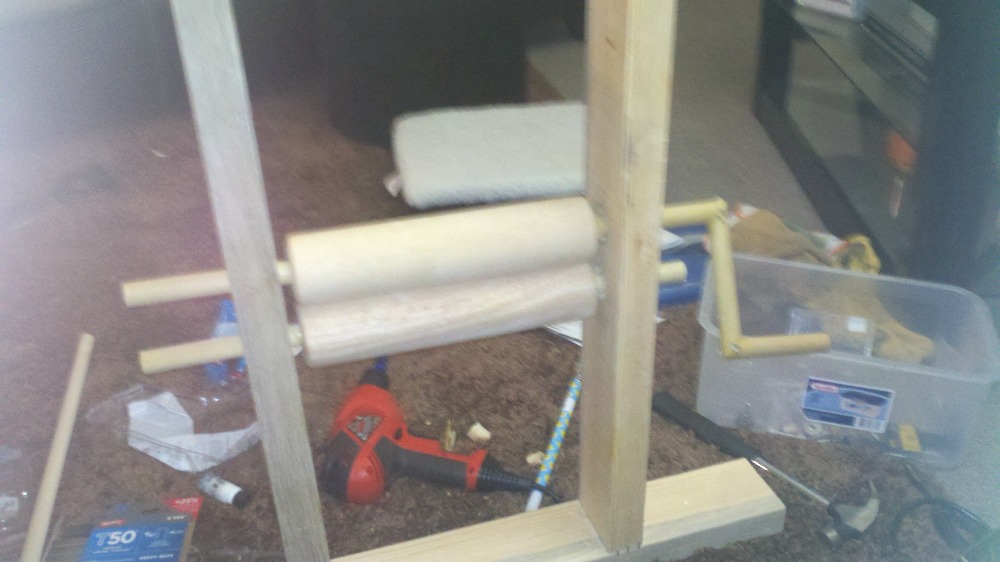To make a clothes wringer with rolling pins, you will need two rolling pins and two C-clamps. Place the clothing between the rolling pins and secure them with the C-clamps.
Tighten the clamps to create pressure on the clothing, then roll the pins across the clothing to squeeze out excess water. This homemade wringer is a simple and effective solution for removing water from clothes.

Credit: www.pinterest.com
Building The Frame
Building the frame for a clothes wringer involves two main steps: cutting the wooden planks and attaching the rolling pins. To begin, measure and mark the desired length for the wooden planks. Use a saw to carefully cut the planks to size, ensuring straight edges. Next, position the planks on a flat surface and secure them together using screws or nails. To attach the rolling pins, place them horizontally across the top of the frame and use screws or brackets to secure them in place. Make sure the rolling pins are evenly spaced and aligned parallel to each other. This will allow for smooth and effective wringing of clothes. Once the rolling pins are attached, the frame is ready for use.

Credit: www.pinterest.com
Assembling The Wringer
When assembling the clothes wringer, it is important to connect the mechanics properly. Start by removing the chicken wire and building the legs. Install the legs and make them collapsible for easy storage. Reinforce the frame to ensure stability. In case of troubleshooting, refer to the instructions provided. Once the wringer is assembled, it is ready to be used for wringing clothes.
After assembling the clothes wringer, it is important to test and adjust it for optimal performance. Test the wringer by placing damp clothes between the rollers and cranking the handle. Adjust the tension and position of the rollers as needed to ensure proper wringing. It is recommended to follow the instructions provided by the manufacturer or refer to online resources for guidance on testing and adjusting the clothes wringer.
| References |
|---|
| Laundry Wringer DiY – YouTube |
| The Most Effective Way to Hand-Wash Clothes in Your Sink |
Rolling clothes in a towel to absorb excess water and gently squeezing them can also be effective for wringing out clothes without a wringer. Be sure to handle delicate fabrics carefully to avoid damage. Reference online resources or consult tutorials for more information on wringing clothes without a wringer.
Using The Diy Clothes Wringer
When it comes to using the DIY clothes wringer, you can prepare the clothes by rolling them into a towel to absorb water and twisting the bundle to squeeze out excess water.
To operate the wringer, carefully lift the garment with both hands and gently squeeze out as much water as possible, then lay it flat on an absorbent towel and roll the towel and garment together.
This method helps to remove excess moisture without causing any damage to the clothes. Additionally, you can make a homemade laundry wringer to effectively wring out clothes without a traditional wringer.

Credit: m.youtube.com
Frequently Asked Questions For How To Make A Clothes Wringer With Rolling Pins
How Do You Get Excess Water Out Of Clothes?
To remove excess water from clothes, roll the wet clothing tightly into a towel. Twist the bundle from one end to the other, squeezing out the water. This helps absorb the water into the towel and leaves your clothes drier.
How Do You Wring Out Clothes Effectively?
To wring out clothes effectively, gently lift the garment with both hands and squeeze out as much water as possible. Lay the garment on an absorbent towel and roll both together to absorb the remaining water. Treat the garment with care throughout the process.
Avoid wringing delicate fabrics to prevent damage.
How Do You Make A Homemade Laundry Wringer?
To make a homemade laundry wringer, attach two rolling pins to a sturdy wooden frame. Place wet clothes between the rolling pins and turn them to squeeze out excess water. This DIY solution effectively wrings clothes for faster drying.
How Do You Wring Clothes Without A Wringer?
To wring clothes without a wringer, carefully lift the garment out of the rinse water and gently squeeze out as much moisture as possible. Lay it flat on an absorbent towel, roll the towel and garment together, gently squeezing as you go, then unroll.
This helps remove excess water effectively.
Conclusion
Creating a clothes wringer with rolling pins is a simple and cost-effective solution for removing excess water from your clothes. With just a few supplies and a little creativity, you can streamline your laundry process and ensure that your garments dry quickly and efficiently.
This DIY method is a practical and sustainable alternative for those looking to simplify their laundry routine.


